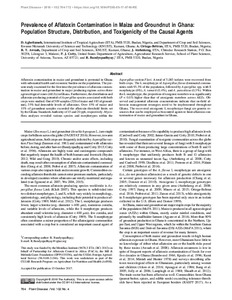| dc.contributor.author | Agbetiameh, D. |
| dc.contributor.author | Ortega-Beltran, A. |
| dc.contributor.author | Awuah, R.T. |
| dc.contributor.author | Atehnkeng, J. |
| dc.contributor.author | Cotty, P.J. |
| dc.contributor.author | Bandyopadhyay, Ranajit |
| dc.date.accessioned | 2019-12-04T11:21:41Z |
| dc.date.available | 2019-12-04T11:21:41Z |
| dc.date.issued | 2018-04 |
| dc.identifier.citation | Agbetiameh, D., Ortega-Beltran, A., Awuah, R.T., Atehnkeng, J., Cotty, P.J. & Bandyopadhyay, R. (2018). Prevalence of aflatoxin contamination in maize and groundnut in Ghana: population structure, distribution, and toxigenicity of the causal agents. Plant Disease, 102(4), 764-772. |
| dc.identifier.issn | 0191-2917 |
| dc.identifier.uri | https://hdl.handle.net/20.500.12478/3849 |
| dc.description | Article purchased |
| dc.description.abstract | Aflatoxin contamination in maize and groundnut is perennial in Ghana with substantial health and economic burden on the population. The present study examined for the first time the prevalence of aflatoxin contamination in maize and groundnut in major producing regions across three agroecological zones (AEZs) in Ghana. Furthermore, the distribution and aflatoxin-producing potential of Aspergillus species associated with both crops were studied. Out of 509 samples (326 of maize and 183 of groundnut), 35% had detectable levels of aflatoxins. Over 15% of maize and 11% of groundnut samples exceeded the aflatoxin threshold limits set by the Ghana Standards Authority of 15 and 20 ppb, respectively. Mycoflora analyses revealed various species and morphotypes within the Aspergillus section Flavi. A total of 5,083 isolates were recovered from both crops. The L morphotype of Aspergillus flavus dominated communities with 93.3% of the population, followed by Aspergillus spp. with S morphotype (6%), A. tamarii (0.4%), and A. parasiticus (0.3%). Within the L morphotype, the proportion of toxigenic members was significantly (P < 0.05) higher than that of atoxigenic members across AEZs. Observed and potential aflatoxin concentrations indicate that on-field aflatoxin management strategies need to be implemented throughout Ghana. The recovered atoxigenic L morphotype fungi are genetic resources that can be employed as biocontrol agents to limit aflatoxin contamination of maize and groundnut in Ghana. |
| dc.description.sponsorship | Bill & Melinda Gates Foundation |
| dc.description.sponsorship | Partnership for Aflatoxin Control in Africa |
| dc.description.sponsorship | United States Department of Agriculture |
| dc.format.extent | 764-772 |
| dc.language.iso | en |
| dc.subject | Aflatoxins |
| dc.subject | Maize |
| dc.subject | Aspergillus Flavus |
| dc.subject | Contamination |
| dc.title | Prevalence of aflatoxin contamination in maize and groundnut in Ghana: population structure, distribution, and toxigenicity of the causal agents |
| dc.type | Journal Article |
| dc.description.version | Peer Review |
| cg.contributor.crp | Agriculture for Nutrition and Health |
| cg.contributor.crp | Maize |
| cg.contributor.affiliation | International Institute of Tropical Agriculture |
| cg.contributor.affiliation | Kwame Nkrumah University of Science and Technology |
| cg.contributor.affiliation | Chitedze Agricultural Research Station, Malawi |
| cg.contributor.affiliation | University of Arizona |
| cg.coverage.region | Africa |
| cg.coverage.region | West Africa |
| cg.coverage.country | Ghana |
| cg.creator.identifier | Alejandro Ortega-Beltran: 0000-0003-3747-8094 |
| cg.creator.identifier | Ranajit Bandyopadhyay: 0000-0003-2422-4298 |
| cg.researchtheme | PLANT PRODUCTION & HEALTH |
| cg.isijournal | ISI Journal |
| cg.authorship.types | CGIAR and developing country institute |
| cg.iitasubject | Maize |
| cg.iitasubject | Plant Diseases |
| cg.iitasubject | Plant Health |
| cg.iitasubject | Plant Production |
| cg.journal | Plant Disease |
| cg.howpublished | Formally Published |
| cg.accessibilitystatus | Limited Access |
| local.dspaceid | 96142 |
| cg.targetaudience | Scientists |
| cg.identifier.doi | https://doi.org/10.1094/PDIS-05-17-0749-RE |

